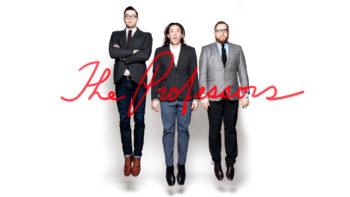Kory Mathewson is a polymath by day and an improvisor by night. Sharing the stage with some of the top improvisors from across Canada, the United States, and Europe, Kory is a tour-de-force of improvisational prowess.
In 2018, Kory co-led the symposium “Machines. Perform. Humans.” in Zurich, Switzerland and presented the work HumanMachine as a featured performance art installation in the art exhibit “100 Ways of Thinking” at the Kunsthalle Zurich. Also in 2018, Kory presented two shows at the Edmonton International Fringe Theatre Festival: TEDxRFT alongside Julian Faid, and HumanMachine alongside Piotr Mirowski. He has performed at the Montreal Improv Festival, the Out of Bounds Comedy Festival, the Bellingham Improv Festival, Rapid Fire Theatre’s Improvaganza in Edmonton, with Outside Joke’s main season in Winnipeg. Kory was the 2014 Artist-in-Residence at the Curious Comedy Theatre in Portland, Oregon. Kory is an innovator in the art form of improvisation, bringing new techniques and formats inspired by his work in cybernetics and artificial intelligence. He is also the mind behind HarshImprovNotes.com, a collection of the world’s worst improv notes ever given and received.
Favourites
TV Shows: Sherlock, Breaking Bad
Movies: Clue, Back to the Future, My Cousin Vinny
Actors: Nicholas Cage
Video Games: QWOP, Geometry Wars
Authors: René Descartes, Maxx Barry, James Stewart
Scientist: Newton, Euler, Euclid, Edison, Tesla, Lauterbur
Music: The Postal Service, Dogshow, Miike Snow
Websites: Hacker News, WordPress.org, Songza
Food: Ribs, Sauce
Places to eat in Edmonton: Sloppy Hoggs Roed Hus, My Hus
I would describe my improv style as a little Gilda Radner mixed with Goldie Hawn. It is committed to the now, always with a wink to the audience. Always watching, always listening.
HOW DID YOU GET INTO IMPROV?
I was introduced to improv by a great friend Joshua “Shecky” Schayer. He invited me to come and watch some improv at lunch during my final year at Ross Sheppard I was immediately enthralled. The spontaneity and vigor of the performance was intoxicating intoxicating. Several weeks passed, and word spread in the Small Town of the extemporaneous universe that a visitor was coming to joining the lunch time improv crew. Little did I know that the aforementioned visitor was none other than me! I was brought up on stage and started rolling with it. No drama class. No training. No workshops. Just jumped in headfirst!
I loved it.
Josh and I soon pulled in our two closest outgoing, extroverted friends, Noah and Tyler, to make a team to compete in the the Nosebowl. We had an incredible time meeting other improvisors from around the city, and performing on a stage in front of hundreds of people. Very fun and we lost miserably!
Next I joined in the rookie jams of Rapid Fire Theatre, which in turn lead to a spot in the company. Since then, I’ve taken it upon myself to engrain myself in the culture of RFT and to help build this wonderful train that just picked me up. This is a crucial point, that RFT is the collective sum of all the parts that help make it what it is. It is built with the hearts and minds of its improvisors, and runs on their passion and tenacity.
WHAT ARE THE KEYS TO A SUCCESSFUL IMPROV SCENE?
First, there are always three keys, no matter what the subject. Good rule. So the keys to a successful improv scene are, of course, three-fold:
- There must be a complete story. For this there are of course three key points.
- Platform
- Change
- Resolution
- It must be appealing to the audience. Audiences do much more than just enjoy the piece, they help create it. They provide cues, verbal or non-, to help us advance and expand the scene as they desire. We are the ultimate flexible performance piece. We contort and twist as we collective agree to be necessary. If there is no response from the audience, not only is it not successful, I don’t believe it is an improv scene.
- Finally, the successfulness of an improv scene is measured in how much of it was improvised. A truly successful scene will be built on true spontaneity. The changes in characters and setting will affect the platform with such magnitude that the emotions of the improvisors will be exuded. The absoluteness of the resolution will never be questioned, and the profoundness of the message, or moral, in the scene will be severe.
WHAT ARE SOME TIPS YOU CAN OFFER AUDIENCE MEMBERS ABOUT GIVING SUGGESTIONS TO IMPROVISORS?
You have such a refined, beautiful control of the show. With one word you can inspire a set of performer’s imaginations more than a feature length film. With a simple response you have the ability to invent a world. Don’t waste your chances. Don’t hesitate. Say the first thing that comes to mind. Sometimes that will be a weird thing, or a gross thing, but we are asking you to improvise in that short moment. Anything is the best thing to say!
WHAT DO YOU LIKE ABOUT SHORT FORM VS. LONG FORM AND VICE VERSA?
Short form challenges the speed with which you can hit the three points of the story. Short form also usually imposes restrictions that the improvisors(s) must follow in the performance of the scene. These both induce a rapid-fire wit and pace to the scene that take the improvisors out of the planning brain and into the now. That is what I love most about short form; when you can see the challenge of the form overcome and the scene invention take place truly without planning.
Conversely, in a long form, you must always stay committed to the platform that you develop. In a long form, all you have is that which has already happened. When you aim for short witty responses in short form, you are not setting yourself up to succeed in the future. You are not being kind to future you. Long form needs care and attention, focus and improv brain where you can sit atop the current scene and think, what is the next scene, or two, or ten, that could happen.
HOW WOULD YOU DESCRIBE YOUR IMPROV STYLE?
I would describe my improv style as a little Gilda Radner mixed with Goldie Hawn. It is committed to the now, always with a wink to the audience. Always watching, always listening.
WHAT ARE YOU TAKING IN SCHOOL?
I am almost done a Master’s in Biomedical Engineering Studying the response of the body, specifically the change in blood flow to the brain, to exercise using MRIs.
WHAT DO YOU HOPE YOUR DEGREE LEADS TO?
I could see myself as a Patch Adams, bringing humor to some of the people that need it most.
HOW DOES YOUR SCIENTIFIC MIND FACTOR INTO YOUR IMPROV?
It provides me a wildly investigative mind on the theories behind the performance. My experimental mind explores the choices that we make and the outcomes that result. It provides a relief from the analytical studies that I love. It allows a certain creativity, and imagination, which does not exist in a scientific prospective.
ARE YOU INVOLVED WITH ANY OTHER IMPROV COMPANIES ASIDE FROM RFT?
I am a cast member with Die Nasty, a weekly long-form soap opera format improv show. As well, each year there are several opportunities around the world to perform in hyper-long-form improvisations, spanning 50 continuous hours. These shows really test the limits of listening, remembering, commitment, and just plain staying awake.
WHAT IS YOUR MOST MEMORABLE MOMENT ON STAGE?
Whatever just happened most recently on stage is always the most important and most memorable moment, because it is what will create the next moment. That being said, standing ovations after performances are the medals that hang in my imaginary improv trophy room.
Kory won the 2013 Canadian Comedy Award for Internet Search History Revealed


